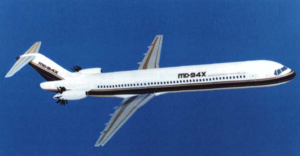| MD-94X | |
|---|---|
 A model of the proposed McDonnell Douglas MD-94X clean-sheet aircraft with two propfan engines. | |
| General information | |
| Type | Airliner |
| National origin | United States |
| Manufacturer | McDonnell Douglas |
| Status | Canceled project |
| Number built | None |
| History | |
| Developed from | McDonnell Douglas MD-80 |
The McDonnell Douglas MD-94X was a planned propfan-powered airliner, intended to begin production in 1994. Announced in January 1986,[1] the aircraft was to seat between 160 and 180 passengers,[2] possibly using a twin-aisle configuration.[3] An all-new design that was investigated internally since at least 1984,[4] the MD-94X was developed in the mid-1980s to compete with the similar Boeing 7J7. The price of oil would have to be at least US$1.40 per gallon for McDonnell Douglas to build the plane, though.[5] Configuration was similar to the MD-80, but advanced technologies such as canard noseplanes,[6] laminar and turbulent boundary layer control, side-stick flight control (via fiber optics), and aluminum-lithium alloy construction were under consideration.[7] Airline interest in the brand-new propfan technology was weak despite claims of up to a 60% reduction in fuel use, and both aircraft were canceled.[citation needed]
Under development at the same time were two propfan-powered commercial variants of the MD-80. The "MD-91X" would have seated 100-110 and entered service in 1991. The "MD-92X," a 150-seat aircraft targeted for service entry in 1992,[2] was originally to be a 76 in stretch (1.9 m) of the MD-80.[3] The price per engine would have been an estimated US$1.6 million dollars more for the propfans than for the MD-80's Pratt & Whitney JT8D-200 series engines.[8] Existing DC-9s and MD-80s would also have been eligible for an upgrade to the new propfan powerplants.[9] On May 19, 1987, McDonnell Douglas tested General Electric Aviation's unducted fan (UDF) engine in flight for the first time on an MD-80 demonstrator,[10] an aircraft that was restored after suffering an empennage separation in 1980 during the landing of a certification test flight for the DC-9 Super 80.[11]
A propfan-powered military variant of the MD-87 or MD-91X, called the P-9D, was also proposed as an anti-submarine warfare (ASW) aircraft. The P-9D was intended for use in the United States Navy's Long Range Air ASW-Capable Aircraft (LRAACA) program, which was to initially replace the existing fleet of 125 Lockheed P-3 Orion aircraft.[12] In October 1988, the Navy selected a derivative of the P-3 Orion (which was later renamed Lockheed P-7A) as the LRAACA aircraft over the P-9D.[13]
On October 10, 1989, McDonnell Douglas publicly announced that it was abandoning the development of propfan-powered aircraft, because of airline companies were concerned about the technology risk and cost compared to a conventionally-powered airliner.[14]
- ^ Cite error: The named reference
Geniewas invoked but never defined (see the help page). - ^ a b Cite error: The named reference
Spinoffwas invoked but never defined (see the help page). - ^ a b Cite error: The named reference
CargoAirliftwas invoked but never defined (see the help page). - ^ Cite error: The named reference
Stitchedwas invoked but never defined (see the help page). - ^ Cite error: The named reference
GAStrongwas invoked but never defined (see the help page). - ^ Cite error: The named reference
ModernAircraftwas invoked but never defined (see the help page). - ^ Cite error: The named reference
ICAS1986was invoked but never defined (see the help page). - ^ Cite error: The named reference
Flying199001was invoked but never defined (see the help page). - ^ Cite error: The named reference
PriceFactorwas invoked but never defined (see the help page). - ^ Cite error: The named reference
JOC19870519was invoked but never defined (see the help page). - ^ Cite error: The named reference
AVG20171225was invoked but never defined (see the help page). - ^ Cite error: The named reference
PropfanASWwas invoked but never defined (see the help page). - ^ Cite error: The named reference
AfterOrionwas invoked but never defined (see the help page). - ^ Vartabedian, Ralph (October 11, 1989). "Douglas unveils 2 jets, drops prop fan". Los Angeles Times. ISSN 0458-3035.